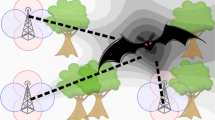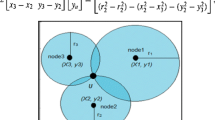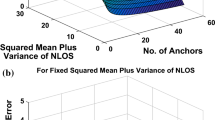Abstract
The localization is an important asset in all existing and emerging wireless networking solutions since it can extend the radio environmental awareness and assist in providing better network operation. The received signal strength (RSS) based non-Bayesian transmitter localization is especially interesting due to the inherent presence of the RSS observations in all commercial radio devices and the instantaneous estimations without the need for extensive training/learning phases. The existing RSS based localization solutions neglect the problems arising from the inherent sensing network topology uncertainty. The sensors, usually assumed to have a-priori known positions, are often a subject of a previous estimation which propagates errors in the transmitter localization procedure, and, hence, results in significant transmitter localization performance degradation. This paper presents a recently developed generic RSS based joint transmitter/sensors localization framework, founded on the assumption of uncertain topology information. The derived joint maximum likelihood (JML) algorithm simultaneously estimates the transmitter and uncertain sensor positions providing twofold gains: improving the transmitter localization and reducing the network topology uncertainty. The paper broadly evaluates the JML algorithm, emphasizing the substantial localization gains originating from the joint transmitter/sensor position estimation. The results prove up to 85 % sensor position uncertainty reduction with the general system model with multiple transmitters locations and multiple previous estimations of the sensors positions. The paper also derives the theoretical lower bounds of the joint estimation framework, and proves the convergence of the JML algorithm. The presented joint estimation framework is applicable to a variety of wireless networking applications. It can provide self-awareness in future wireless networks and cope with the environment and topology dynamism in wireless ad-hoc networks.









Similar content being viewed by others
References
Shen, Y., & Win, M. Z. (2010). Fundamental limits of wideband localization Part I: A general framework. IEEE Transactions on Information Theory, 56(10), 4956–4980.
Shen, Y., & Win, M. Z. (2010). Fundamental limits of wideband localization Part II: Cooperative networks. IEEE Transactions on Information Theory, 56(10), 4981–5000.
Martin, R. K., & Thomas, R. (2009). Algorithms and bounds for estimating location, directionality and environmental parameters of primary spectrum users. IEEE Transactions on Wireless Communications, 8(11), 5692–5701.
Dagres, I., Poydoros, A., Denkovski, D., Angjelicinoski, M., Atanasovski, V., & Gavrilovska, L. (2012). Algorithms and bounds for energy-based multi-source localization in log-normal fading. In Proceedings of IEEE GLOBECOM Workshops (GC Wkshps) 2012 (pp. 410–415). California, USA: Anaheim.
Denkovski, D., Angjelicinoski, M., Atanasovski, V., & Gavrilovska, L. (2012). Practical assessment of RSS-based localization in indoor environments. Presented at the IEEE Military Communications Conference 2012. Florida, USA: Orlando.
Atanasovski, V. et al. (2011). Constructing radio environment maps with heterogeneous spectrum sensors. In IEEE DySPAN 2011 demonstration, Aachen, Germany, (best demo award).
Gavrilovska, L., Atanasovski, V., Rakovic, V., & Denkovski, D. (2014). Integration of heterogeneous spectrum sensing devices towards accurate REM construction. Cognitive Communication and Cooperative HetNet Coexistence, Series: Signals and Communication Technology (pp. 187–210). Springer.
Zekavat, R., & Buehrer, R. (2012). Handbook of position location: Theory, practice and advances. Wiley-IEEE Press.
Kay, S. M. (1998). Fundamentals of statistical signal processing: Estimation theory (Vol. 1). Prentice-Hall PTR.
Gavrilovska, L., Atanasovski, V., Rakovic, V., Denkovski, D., & Angjelicinoski, M. (2013). REM-enabled transmitter localization for ad-hoc scenarios. IEEE MILCOM 2013. CA, USA: San Diego.
Angjelicinoski, M., Denkovski, D., Atanasovski V., & Gavrilovska, L. (2014). SPEAR: Source position estimation for anchor position uncertainty reduction. In IEEE Communications Letters, (accepted).
Hemmes, J., Thain, D., & Poellabauer C. (2009). Cooperative localization in GPS-limited urban environments. In Proceedings of 2009 International Conference on Ad Hoc Networks: Revised Selected Papers (pp. 422437) Ontario, Springer.
Rockah, Y., & Schultheiss, P. M. (1987). Array shape calibration using sources in unknown locations part I: Far-field sources. IEEE Transactions on Acoustics, Speech and Signal Processing, 35(3), 286299.
Vemula, M., Bugallo, M. F., & Djuric, P. M. (2009). Sensor self-localization with beacon position uncertainty. Signal Processing Journal, 89(9), 11441154.
Munoz, D., Boucherau, C., Vargas, C., & Enriquez, R. (1993). Position location techniques and applications. Amsterdam: Elsevier Inc.
Chrysikos, T., & Kotsiopoulos, S. (2009). Impact of channel-dependent variation of path loss exponent on wireless information-theoretic security. In Wireless Telecommunications Symposium (WTS) 2009. Prague: Czech Republic.
Eldar, Y. C. (2008). MSE bounds with affine bias dominating the Cramer–Rao bound. IEEE Transactions on Signal Processing, 56(8), 3824–3836.
Kay, S., & Eldar, Y. C. (2008). Rethinking biased estimation. IEEE Signal Processing Magazine, 25(3), 133–136.
FP7 ICT-257626 ACROPOLIS project, Deliverable D10.2: Home and Alien Network Discovery, Awareness and Management Network Discovery Solutions, (2012).
FP7 ICT-248351 FARAMIR project, Deliverable D4.2: Neighborhood Mapping Technology and Algorithm Report, (2011).
L. Gavrilovska and R. Prasad, Ad-Hoc Networking Towards Seamless Communications, Signals and Communication Technology, (2006).
Mauve, M., Widmer, J., & Hartenstein, H. (2001). A survey on position-based routing in mobile ad hoc networks. IEEE Network, 15(6), 30–39.
FP7 ICT-610658 eWall project for long and active living, Information. http://ewallproject.eu/, (2014).
3GPP TS 37.320 v10.0.0, Radio measurement collection for Minimization of Drive Tests (MDT), Overall description, Stage 2, (2012).
Mohapatra, D., & Suma, S. B. (2005). Survey of location based wireless services. IEEE ICPWC, 2005, 358–362.
NATO SfP-984409 Optimization and Rational Use of Wireless Communication Bands (ORCA). http://orca.feit.ukim.edu.mk/ (2014).
Acknowledgments
This work is sponsored by the Public Diplomacy Division of NATO in the framework of Science for Peace through the SfP-984409 Optimization and Rational Use of Wireless Communication Bands (ORCA) project [26]. The authors would like to thank everyone involved.
Author information
Authors and Affiliations
Corresponding author
Rights and permissions
About this article
Cite this article
Denkovski, D., Angjelichinoski, M., Atanasovski, V. et al. RSS-Based Self-Localization Framework for Future Wireless Networks. Wireless Pers Commun 78, 1755–1776 (2014). https://doi.org/10.1007/s11277-014-1903-z
Published:
Issue Date:
DOI: https://doi.org/10.1007/s11277-014-1903-z




